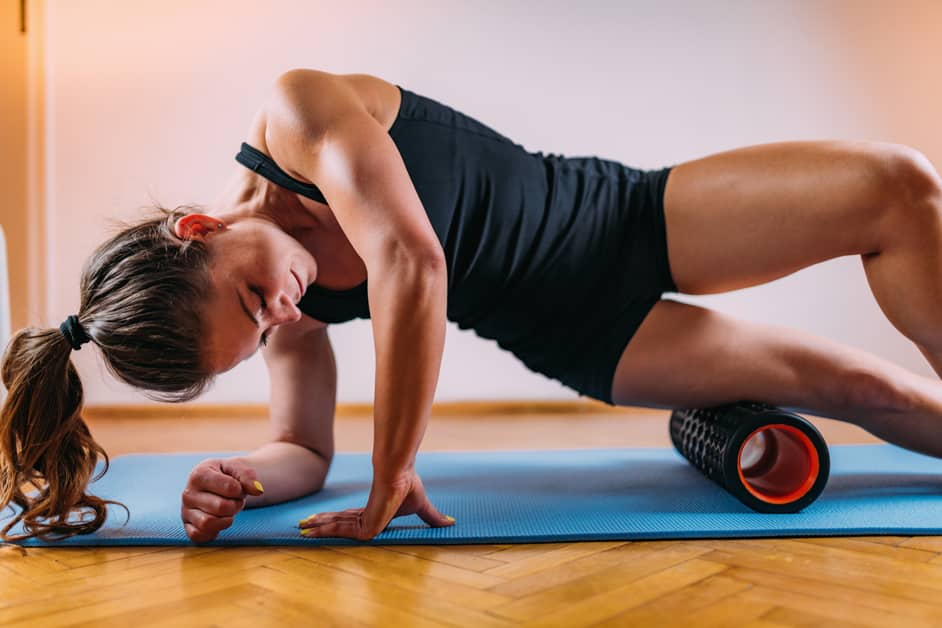Introduction
Knee pain can have various causes, like osteoarthritis, tendinitis, bursitis and more. Treatments involve medications and surgery, but a foam roller is also a great way to reduce pain and improve movement in the knee joint.
This guide will explain how to use a foam roller for knee pain and how to make the most of it:
What is a Foam Roller?
Foam rollers are amazing tools! They help reduce swelling, improve mobility of muscles, and increase flexibility. Plus, there are many sizes, textures, and densities. Simply put, foam rollers are cylinders made of foam that apply pressure on your muscles as you roll back and forth. Fitness experts and physical therapists often use foam rolling as a form of self-massage.
The idea of foam rolling started in physical therapy to make body tightness easier. It works by using your body weight to enhance blood flow to the soft tissue, which helps avoid injury and decrease time for healing. Plus, it is thought to be better than manual massages at targeting trigger points. So, foam rolling is a great way to give relief from muscle tension due to exercise or daily life!
Benefits of Foam Rolling
Foam rolling is a great way to combat knee pain and stiffness. It’s a self-myofascial release technique that reduces muscular tension, tightness and pain. It also helps with circulation, releasing fascia and restoring muscle movement. Blood flow is increased, reducing inflammation and helping with recovery after exercise like running or walking.
Foam rolling can help with posture, injury prevention, muscle regeneration, stiffness and flexibility. Plus, it’s cost-effective and can be done at home without special equipment. But make sure to practice proper form and not over-stretch or strain your body. If you’re unsure, ask a healthcare professional for advice.
If used correctly, foam rolling can help with knee pain quickly. It works on areas like hamstrings, quadriceps, calf muscles, hip flexors and abdominal muscles, depending on your pain when exercising.
Preparing to Foam Roll
Before foam rolling for knee pain, it’s important to warm up. Increase bloodflow and reduce the risk of injury by doing bodyweight exercises like squats, lunges, and leg swings. Additionally, use a stretching band to target the muscles around your knee. This will create a safe and effective environment for foam rolling.
Choosing the Right Foam Roller
When picking a foam roller, many things to take into account. The density of the roller should fit the area you plan to roll. Also, size and shape matter for comfort.
Most foam rollers come in two densities: standard (soft) and extra firm (hard). A soft one is great to warm up and massage before exercise. An extra firm roller is better for soreness relief afterwards.
Size varies from four to eight inches in diameter. Bigger ones are great for larger muscles like quads or hamstrings. Smaller ones work for tight, small spots like round joints. It must be flexible to bend around curves and durable enough to support rolling.
Shapes vary too. Cylindrical styles and ergonomic curvilinear ones. Narrow rollers work better for hard-to-reach spots with more severe soreness than flat ones.
Finding the Right Spot to Foam Roll
Foam rolling is great, but it’s important to know where to roll on your body. Any area can be targeted, but for knee pain specifically, there are key spots. Start with the quadriceps and roll from top to bottom. Place the roller underneath your knee for support. You may find sore areas, but keep going until the area is warm to break up tightness and stretch muscles. If it’s too painful, stop and get help from a physical therapist or doctor.
Foam rolling can help with existing and future knee pain, but use it regularly and be mindful of potential risks.
Safety Tips
Safety is key when foam rolling. Here are tips to make sure your experience is safe and successful:
- Choose a foam roller that is not too hard for you. Softer rollers are better for those just starting out.
- Warm up with dynamic stretching or a light jog before using the foam roller.
- Start with gentle pressure and gradually increase as needed.
- Don’t roll directly over joints like elbows and knees; move around them.
- Don’t roll any area for more than thirty seconds.
- Use pressure and movement together for the best outcome.
- After finishing an area, take some deep breaths for a few moments before moving on. This will help circulation and relaxation of the tissue.
Foam Rolling Techniques
Foam rolling is a great way to help with knee pain and maintain joint health. It’s an easy technique that you can do at home with a foam roller. Not familiar with foam rolling? Don’t worry! We’ll go over how to do it right and the potential benefits:
The Basic Foam Rolling Technique
Foam rolling is a technique for relieving muscle soreness and tightness. It isn’t deep tissue massage, instead it helps reduce tension and increase range of motion. You can use it on almost any area of the body, but start small and work your way up.
To do it correctly:
- Place the foam roller under the target muscle group. Make sure two-thirds to three-fourths of your weight is on the roller.
- Move your body back and forth slowly on the roller for 30 seconds, applying light pressure if you need relief.
- Once done, switch sides and repeat. Rest for at least 30 seconds before moving onto another muscle group or ending the session.
Foam rolling isn’t a quick fix. It’s an exercise routine. With regular use, you should start to notice improvements in mobility and relaxation. You may also have better posture.
Foam Rolling for Knee Pain
Foam rolling is great for relieving pain and discomfort in the joints, especially the knees. It increases flexibility, mobility and range of motion and speeds up recovery time post-exercise. Furthermore, it can also reduce stress and anxiety levels and improve overall wellbeing.
To get the most out of foam rolling for knee pain, you should lie on your back with both legs straight. Place a foam roller underneath the affected knee. Use your hands to apply pressure and make small circular motions around the knee joint. This will break up tightness and improve blood circulation.
Next, move up and down your thigh while still using the foam roller. Do this 8-10 times on each side of the knee. Other techniques such as side-to-side or up-and-down movements across your quadriceps or calf muscles can also be used.
Finally, don’t forget to stretch after rolling. This helps elongate your muscle fibers and ensures all the benefits from using a foam roller are felt!
Conclusion
A foam roller is a great tool for lessening or eliminating knee discomfort. Use it regularly with other pain management strategies for maximum effect.
This guide covers the rewards of foam rolling, how to do it right, and how to combine it with other self-care techniques. Plus, it looks at the potential risks of foam rolling.
Tips for Long-Term Results
Foam rolling can be a great way to reduce knee pain on the long-term. Here are some tips to follow:
- Make a regular foam rolling routine. Doing this daily will give you the most benefit. You’ll become aware of your body and how you move, leading to quicker gains.
- When rolling, use moderate pressure. Stop when you find a reactive spot. Spend extra time rolling these until you feel relief or reduced tightness.
- Roll all relevant muscles around the knees. They’ll likely influence knee pain too (HIP FLEXRES, QUADRICEPS MUSCLE, GLUTEUS MEDIOUS). This helps give balance in strength and flexibility between the muscles, giving better results.
- Drink water before and after foam rolling. Dehydration can lead to inflammation, so make sure you’re hydrated for maximum benefit!
When to See a Doctor
No matter the stretches or treatments you use to manage your knee pain, it’s best to talk to a doctor if:
- You have strong pain that won’t go away after a few days of rest, ice or heat
- You feel a tingling in the area
- Your lower leg feels numb
- The joint is swollen
- You can’t bear weight on the leg
- You can’t move or bend it like before
- You hear crunching when you bend the joint.
Generally, it’s suggested to always contact your doctor if you have knee pain that lasts more than two weeks. If a physical therapist finds an injury like tendinitis or bursitis, they’ll suggest an appropriate plan. This could include changing activities and exercises, such as foam rolling. In some cases, surgery may be needed. Your healthcare team will help you find the best solution for your needs.
Frequently Asked Questions
Question 1: What is a foam roller?
Answer: A foam roller is a cylindrical piece of foam used for self-massage and other exercise techniques. It is designed to help relax tight muscles and improve flexibility.
Question 2: How can a foam roller help with knee pain?
Answer: Foam rolling can help reduce tension in the muscles around the knee, which can help reduce pain and improve mobility. It also helps improve circulation and restore proper joint movement.
Question 3: How often should I use a foam roller for knee pain?
Answer: It is recommended to foam roll the muscles around the knee two to three times a week. Start with a gentle massage and build up to more pressure as your muscles become accustomed to the foam roller.





